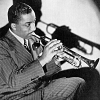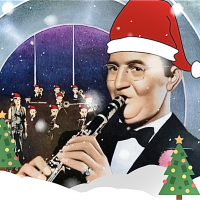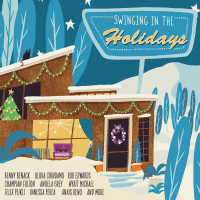Home » Jazz Musicians » Jimmie Lunceford
Jimmie Lunceford
Jimmie Lunceford led what many consider to be the best swing orchestra of the 1930s. Flashy and talented, Lunceford's band was without a doubt the most entertaining of its day. No one who saw it in performance could ignore the group's infectious attitude and enthusiastic presence. Many of the era's top bandleaders openly borrowed from Lunceford's showmanship. Lunceford spent his formative years in Denver, Colorado, where he studied music under Paul Whiteman's father and in 1922 played saxophone with George Morrison's orchestra at the Empress Theatre. In 1926 he earned a bachelor's degree from Fisk University in Nashville. Lunceford also attended the City College in New York. During school breaks he performed with such artists as Wilbur Sweatman, Elmer Snowden, John C. Smith, and Deacon Jones. After graduation Lunceford taught high school in Memphis, Tennessee. In 1927 he formed a student band, the Chickasaw Syncopaters. The Syncopaters went professional in 1929, making their recording debut in 1930. They worked in both Cleveland and Buffalo before settling in New York in 1933, where they earned a spot at the Cotton Club. By that time known as the Jimmie Lunceford Orchestra, the group proved quite popular and quickly emerged as one of the top bands in the country. Though at first influenced by the Casa Loma Orchestra Lunceford's band soon developed its own unique sound, led by the masterful arrangements of trumpeter Sy Oliver. Noted musicians include trombonists Eddie Durham and Trummy Young, saxophonists Willie Smith and Joe Thomas, trumpeter Paul Webster, and pianist Eddie Wilcox. Vocals were provided by many of the musicians themselves, all multi-talented performers. In 1935 a long list of superb Decca two-beat recordings associated with Lunceford's name but written by Sy Oliver began; “For Dancers Only,” “Margie,” “Posin,” “Slumming On Park Avenue,” “My Blue Heaven,” “Organ Grinders Swing,” etc. are still great listens today. Unfortunately, based on the merits of his band's recordings, Lunceford may never receive his just due as a leader simply because his group's superb showmanship is lost on record. Lunceford's orchestra was best a live experience. The band prided itself on its showmanship. Members dressed impeccably, often changing uniforms several times during the night. Famous was the trumpet section, which would toss their instruments into the air during breaks. Lunceford suffered a setback in 1939 when Oliver left the band to join Tommy Dorsey. Gerald Wilson and Bill Moore Jr. took his place as arrangers.
Read moreTags
Jimmie Lunceford: The Complete Jimmie Lunceford Decca Sessions

by David Rickert
When saxophonist Jimmie Lunceford signed to the Decca label in 1934 he was running one of the best orchestras in the US. He had signed a deal to appear at the Cotton Club (where bandleaders Duke Ellington and Cab Calloway had recently launched into stardom) and was frequently beating others in battles of the bands, all the while leading an outfit with an uncanny amount of precision and professionalism. Even Glenn Miller claimed that when Lunceford's band was at its ...
Continue ReadingJimmie Lunceford and His Orchestra: 1943-45 Broadcasts

by Jack Bowers
Somewhere between the enduring Swing Era “superstars” (Ellington, Basie, Miller, the Dorsey brothers, Harry James, Artie Shaw) and the scarcely remembered “regional bands” stood such enormously popular (and talented) but relatively short–lived “second tier” orchestras as those led by Fletcher Henderson, Don Redman, Chick Webb, Andy Kirk, Jay McShann, Jimmie Lunceford and others. Lunceford’s ensemble was at its peak in the mid– to late–’30s before the great arranger Sy Oliver left to join the Tommy Dorsey Orchestra. These performances, taped ...
Continue ReadingJimmie Lunceford Awarded Note on Memphis' Beale Street Walk of Fame

Source:
Michael Ricci
Jimmie Lunceford, storied bandleader and educator was awarded a note on the Beale Street Walk of Fame in Memphis, Tennessee on Sunday, July 19. His note will join the likes of those who have had a tremendous impact on the City of Memphis as a musical center.
Lunceford, who first came to Memphis in 1926 as a coach at Manassas High School, established the first music program in Memphis City Schools. Lunceford's groups went on to tour professionally and have ...
read more
Requesting Sponsorship Support for the 1st Annual Jimmie Lunceford Jamboree Festival in Memphis, TN

Source:
All About Jazz
Dear Potential Sponsor, Please join us in this historic occasion to honor one of Memphis' unfairly forgotten yet greatest musicians, visionaries and sons, the incomparable Jimmie Lunceford. Please sponsor and support the first annual Jimmie Lunceford Jamboree Festival. This three day celebration will take place on October 19-21 2007 throughout various locations in the city. Purpose Of The Jimmie Lunceford Jamboree Festival: To Honor And Bring Awareness To The Forgotten And Impressive Legacy And Achievements Of Jimmie Lunceford, The First ...
read more



































